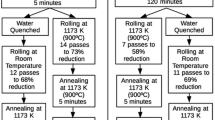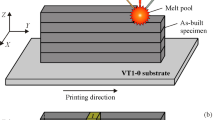Abstract
The effect of furnace heat treatments to 850 °C, on the evolution of microstructure in Ti–6Al–4V alloy produced via selective laser melting (SLM), was studied using optical microscopy, X-ray diffraction (XRD), and transmission electron microscopy (TEM). Columnar prior-β grains in the build direction with lamellar α-martensite laths contained within the prior-β grains were determined. α-martensite laths present in the as-built microstructure had thicknesses around 236 nm while the heat-treated microstructure showed an α-lath thickness values of around 1.8 μm. Based on XRD analysis, upon heat treatment the formation of β-phase was determined with associated peaks around 41° and 58°, corresponding to (110) and (200) planes, respectively.
Access this chapter
Tax calculation will be finalised at checkout
Purchases are for personal use only
Similar content being viewed by others
References
Gao W, Zhang Y, Ramanujan D et al (2015) The status, challenges, and future of additive manufacturing in engineering. Comput Aided Des 69:65–89. https://doi.org/10.1016/j.cad.2015.04.001
Levy GN, Schindel R, Kruth JP (2003) Rapid manufacturing and rapid tooling with layer manufacturing (LM) technologies, state of the art and future perspectives. CIRP Ann 52:589–609. https://doi.org/10.1016/S0007-8506(07)60206-6
Yadroitsev I, Krakhmalev P, Yadroitsava I (2014) Selective laser melting of Ti6Al4V alloy for biomedical applications: temperature monitoring and microstructural evolution. J Alloy Compd 583:404–409. https://doi.org/10.1016/j.jallcom.2013.08.183
Wang X, Xu S, Zhou S et al (2016) Topological design and additive manufacturing of porous metals for bone scaffolds and orthopaedic implants: a review. Biomaterials 83:127–141. https://doi.org/10.1016/j.biomaterials.2016.01.012
Cheng XY, Li SJ, Murr LE et al (2012) Compression deformation behavior of Ti–6Al–4V alloy with cellular structures fabricated by electron beam melting. J Mech Behav Biomed Mater 16:153–162. https://doi.org/10.1016/j.jmbbm.2012.10.005
Chan KS, Koike M, Mason PL, Okabe T (2013) Fatigue life of titanium alloys fabricated by additive layer manufacturing techniques for dental implants. Metall Mater Trans A 44(2):1010–1022. https://doi.org/10.1007/s11661-012-1470-4
Oliveira TT, Reis AC (2019) Fabrication of dental implants by the additive manufacturing method: a systematic review. J Prosthet Dent 122:270–274. https://doi.org/10.1016/j.prosdent.2019.01.018
Cronskär M, Bäckström M, Rännar L-E (2013) Production of customized hip stem prostheses—a comparison between conventional machining and electron beam melting (EBM). Rapid Prototyp J Bradford 19:365–372. http://dx.doi.org.ucd.idm.oclc.org/10.1108/RPJ-07-2011-0067
Meena VK, Kumar P, Kalra P, Sinha RK (2021) Additive manufacturing for metallic spinal implants: a systematic review. Ann 3D Print Med 3:100021. https://doi.org/10.1016/j.stlm.2021.100021
Cunningham R, Narra SP, Ozturk T et al (2016) Evaluating the effect of processing parameters on porosity in electron beam melted Ti-6Al-4V via synchrotron X-ray microtomography. JOM 68:765–771. https://doi.org/10.1007/s11837-015-1802-0
Ponader S, von Wilmowsky C, Widenmayer M et al (2010) In vivo performance of selective electron beam-melted Ti-6Al-4V structures. J Biomed Mater Res Part A 92A:56–62. https://doi.org/10.1002/jbm.a.32337
Murr LE, Amato KN, Li SJ et al (2011) Microstructure and mechanical properties of open-cellular biomaterials prototypes for total knee replacement implants fabricated by electron beam melting. J Mech Behav Biomed Mater 4:1396–1411. https://doi.org/10.1016/j.jmbbm.2011.05.010
Zhang L-C, Liu Y, Li S, Hao Y (2018) Additive manufacturing of titanium alloys by electron beam melting: a review. Adv Eng Mater 20:1700842. https://doi.org/10.1002/adem.201700842
DebRoy T, Wei HL, Zuback JS et al (2018) Additive manufacturing of metallic components—Process, structure and properties. Prog Mater Sci 92:112–224. https://doi.org/10.1016/j.pmatsci.2017.10.001
Sing SL, An J, Yeong WY, Wiria FE (2016) Laser and electron-beam powder-bed additive manufacturing of metallic implants: a review on processes, materials and designs. J Orthop Res 34:369–385. https://doi.org/10.1002/jor.23075
Leyens C, Peters M (Eds.) (2003) Titanium and titanium alloys: fundamentals and applications. 1st ed. Wiley. https://doi.org/10.1002/3527602119
Filip R, Kubiak K, Ziaja W, Sieniawski J (2003) The effect of microstructure on the mechanical properties of two-phase titanium alloys. J Mater Process Technol 133:84–89. https://doi.org/10.1016/S0924-0136(02)00248-0
Tan X, Kok Y, Tan YJ et al (2015) Graded microstructure and mechanical properties of additive manufactured Ti–6Al–4V via electron beam melting. Acta Mater 97:1–16. https://doi.org/10.1016/j.actamat.2015.06.036
ASM handbook additive manufacturing of titanium alloys. In: Additive manufacturing processes
ASM Handbook (1985) Metals handbook desk edition
Safdar A, Wei L-Y, Snis A, Lai Z (2012) Evaluation of microstructural development in electron beam melted Ti-6Al-4V. Mater Charact 65:8–15. https://doi.org/10.1016/j.matchar.2011.12.008
Galarraga H, Warren RJ, Lados DA et al (2017) Effects of heat treatments on microstructure and properties of Ti-6Al-4V ELI alloy fabricated by electron beam melting (EBM). Mater Sci Eng A 685:417–428. https://doi.org/10.1016/j.msea.2017.01.019
Xu W, Brandt M, Sun S et al (2015) Additive manufacturing of strong and ductile Ti–6Al–4V by selective laser melting via in situ martensite decomposition. Acta Mater 85:74–84. https://doi.org/10.1016/j.actamat.2014.11.028
Al-Bermani SS, Blackmore ML, Zhang W, Todd I (2010) The origin of microstructural diversity, texture, and mechanical properties in electron beam melted Ti-6Al-4V. Metall Mater Trans A 41:3422–3434. https://doi.org/10.1007/s11661-010-0397-x
Kaschel FR, Celikin M, Dowling DP (2020) Effects of laser power on geometry, microstructure and mechanical properties of printed Ti-6Al-4V parts. J Mater Process Technol 278:116539. https://doi.org/10.1016/j.jmatprotec.2019.116539
Rafi HK, Karthik NV, Gong H et al (2013) Microstructures and mechanical properties of Ti6Al4V parts fabricated by selective laser melting and electron beam melting. J Mater Eng Perform 22:3872–3883. https://doi.org/10.1007/s11665-013-0658-0
Leuders S (2013) On the mechanical behaviour of titanium alloy TiAl6V4 manufactured by selective laser melting: fatigue resistance and crack growth performance. Int J Fatigue 8. https://doi.org/10.1016/j.ijfatigue.2012.11.011
Ter Haar G, Becker T (2018) Selective laser melting produced Ti-6Al-4V: post-process heat treatments to achieve superior tensile properties. Materials 11:146. https://doi.org/10.3390/ma11010146
Vrancken B, Thijs L, Kruth J-P, Van Humbeeck J (2012) Heat treatment of Ti6Al4V produced by selective laser melting: microstructure and mechanical properties. J Alloy Compd 541:177–185. https://doi.org/10.1016/j.jallcom.2012.07.022
Piazza S, Merrigan B, Dowling DP, Celikin M (2020) The effects of geometry and laser power on the porosity and melt pool formation in additively manufactured 316L stainless steel. Int J Adv Manuf Technol 111:1457–1470. https://doi.org/10.1007/s00170-020-06196-8
Wysocki B, Maj P, Sitek R et al (2017) Laser and electron beam additive manufacturing methods of fabricating titanium bone implants. Appl Sci 7:657. https://doi.org/10.3390/app7070657
Kaschel FR, Vijayaraghavan RK, Shmeliov A et al (2020) Mechanism of stress relaxation and phase transformation in additively manufactured Ti-6Al-4V via in situ high temperature XRD and TEM analyses. Acta Mater 188:720–732. https://doi.org/10.1016/j.actamat.2020.02.056
Acknowledgements
This publication has emanated from research conducted with the financial support of Science Foundation Ireland under Grant Number 16/RC/3872. For the purpose of Open Access, the author has applied a CC BY public copyright license to any Author Accepted Manuscript version arising from this submission.
Funding
This research was co-funded by the Science Foundation Ireland (SFI) and Stryker through I-Form, the SFI Research Centre for Advanced Manufacturing, and the Advanced Metallic Systems Centre for Doctorial Training (AMS–CDT).
Author information
Authors and Affiliations
Contributions
Bryan Naab: Investigation, Writing—Original Draft.
Mert Celikin: Writing—Review & Editing, Supervision.
Denis Dowling: Writing—Review & Editing, Supervision.
Corresponding author
Editor information
Editors and Affiliations
Ethics declarations
The authors declare the following financial interests/personal relationships which may be considered as potential competing interests: “This work was partially sponsored by Stryker, a medical technologies cooperation that uses additively manufactured Ti-6Al-4V in some of their products”.
Originality statement
I write on behalf of myself and all co-authors to confirm that the results reported in the manuscript are original and neither the entire work, nor any of its parts have been previously published. The authors confirm that the article has not been submitted to peer review, nor has been accepted for publishing in another journal. The author(s) confirms that the research in their work is original, and that all the data given in the article are real and authentic.
Rights and permissions
Copyright information
© 2022 The Minerals, Metals & Materials Society
About this paper
Cite this paper
Naab, B., Dowling, D.P., Celikin, M. (2022). The Study on Microstructural Evolution During Post-processing of Additively Manufactured Ti64. In: TMS 2022 151st Annual Meeting & Exhibition Supplemental Proceedings. The Minerals, Metals & Materials Series. Springer, Cham. https://doi.org/10.1007/978-3-030-92381-5_18
Download citation
DOI: https://doi.org/10.1007/978-3-030-92381-5_18
Published:
Publisher Name: Springer, Cham
Print ISBN: 978-3-030-92380-8
Online ISBN: 978-3-030-92381-5
eBook Packages: Chemistry and Materials ScienceChemistry and Material Science (R0)




